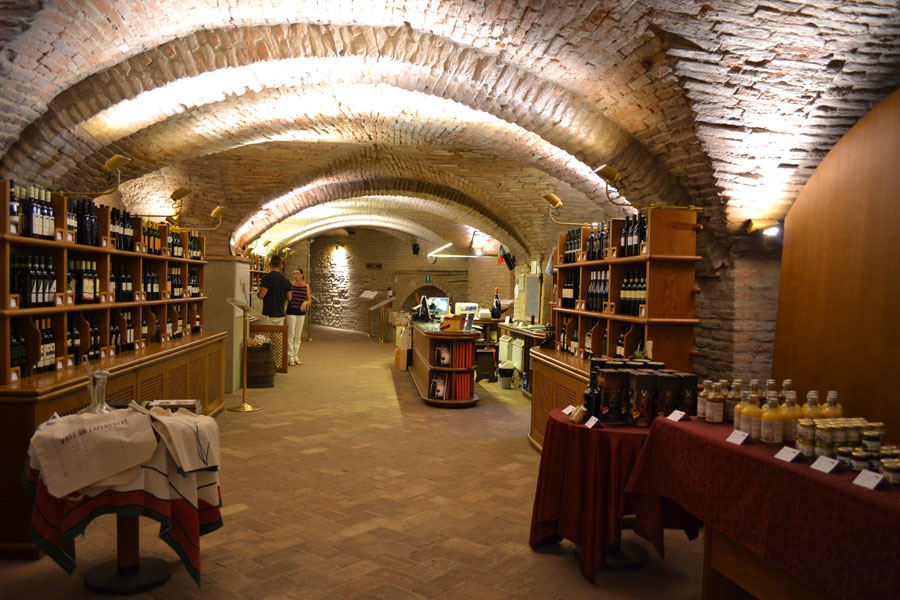Perched on a hill overlooking the valley of the river Sellustra, surrounded by vineyards, Dozza is a medieval village 35 minutes from Bologna, right on the border between Emilia and Romagna, classified as one of the “100 most beautiful borghi (historic villages) of Italy.”
Discover Dozza The entrance to Dozza is clearly marked by a massive arched wall. The village is crossed by two main roads, Via XX Settembre and Via De Amicis, adorned by painted walls, a distinctive feature of this village. Every two years in September in fact, artists from all over the world gather here to paint the walls of buildings around the town center for the "Biennale del Muro Dipinto."

Both roads take visitors to the massive Rocca Sforzesca. Built in the 13th century as a fortress to dominate and protect the surrounding territory, it later became a noble palace belonging to various local families. Today, it houses a museum where you can visit the old apartments, the prisons, the torture rooms and the walkways on the towers. But perhaps its most attractive feature today is housed in the vaulted basement: the beautiful, well-stocked wine cellar of the Enoteca Regionale Emilia Romagna, the association that has been promoting the wines of Emilia-Romagna since 1978. Here, visitors can choose among 1,000 labels from 260 regional wine producers and participate in a series of fun and instructional events, including courses, meetings with local producers and tastings with a sommelier.

Emilia-Romagna wines From the well-known Sangiovese and Lambrusco to the sparkling Pignoletto to the funny-named Burson and Centesimino, Emilia-Romagna boasts a great variety of wines. The region has a growing relevance in the world of Italian wines: it produces 15% of Italian wine and has seen a steady increase in exports, with the biggest markets represented by Germany, the United States, England, Switzerland, and increasingly Russia, China and Brasil.
History To understand how the production of wine has evolved here, you need to understand how Emilia and Romagna, which together form the region, experienced two different occupation histories. Emilia was settled by Barbarian populations, whose diet relied heavily on butter and pork meat; these leave a sensation of fatness in the mouth, which can be balanced out by a sparkling wine. In fact, Emilia is a big producer and exporter of sparkling wines. Romagna, on the other hand, was colonized by the Romans, who made heavy use of olive oil, which leaves an oily, not fatty, sensation in the mouth, needing wine with a certain structure to restore a balance of flavors in the mouth. This also explains why food and wine pairing is so important. 
Primary types of Emilia-Romagna wines Below is a list of the main Emilia-Romagna wines by geographic area, but be aware that there are many variations on the same vine and smaller productions as well. Colli Piacentini: the hills and valleys around Piacenza, in the north-western tip of the region. The two most important wines produced here are:
Gutturnio. Its names derives from the latin word gutturnum, the name of a cup that the Romans used for drinking during festivities. Gutturnio is a bright, ruby red wine, traditionally sparkling and young; it goes well with soups, red and white meat roasts, and fried dishes.
Malvasia. Aromatic white wine, characterized by many fragrances. The dry version goes well with appetizers, pasta, white meat and fish. The most famous version is Malvasia di Candia. Colli di Parma: proceeding south along the Via Emilia, the old Roman road that cuts across the region, we find the enchanting hills around Parma, between the Enza and Stirano rivers. The main wines here are:
Malvasia. See above.
Barbera. Ruby red wine with an intense color. Dry, full-bodied, intense flavor. It is excellent with boiled pork and roasted lamb.
Bonarda. Ruby red wine with a fruity bouquet and a flavor that varies from dry to sweet. Ideal with pasta with meat sauce, roasted meat and sharp cheeses. Parma, Reggio Emilia and Modena: further south, along the via Emilia, are the lands of:
Lambrusco. Red wine, ranging from a ruby to intense red color, it has a fruity to floral fragrance, a pleasant acidity and a moderate alcoholic content. The regular version (fizzy) pairs well with pasta with beans (pasta e fagioli) and boiled meat, while the spumante and semi-sparkling versions are excellent with appetizers, cold cuts and medium-aged cheeses. Please note that there are many different versions of Lambrusco! Colli Bolognesi: the hills around Bologna, in the central part of the region.
Pignoletto. Cited by Pliny the Elder in the 1st century B.C., it was recognized as the second DOCG of Emilia-Romagna in 2010. Prestigious white wine, with a light yellow color, it has a delicate flavor and well-balanced taste. Excellent with appetizers, broth tortellini and seafood. Romagna: this is the area occupying the south-eastern portion of the region, characterized by hills where some of the most famous wines are produced, including:
Albana. The first white wine in Italy to obtain the DOCG recognition (1987), it has been produced since Roman times. It is made in four versions, including dry, which goes well with any type of food, and sweet, perfect with cakes.
Sangiovese. The signature Romagna wine! Ruby-red color with violet nuances, dry, full, smooth taste, it is excellent with roasts and grilled meats. 
What’s your favorite Emilia-Romagna wine?






